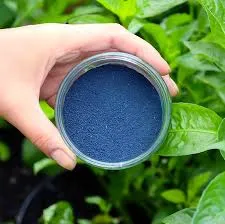dye indigo plant
The Indigo Plant A Historical and Cultural Perspective on Dye Production
The indigo plant, scientifically known as *Indigofera tinctoria*, is a flowering plant that has played a pivotal role in the history of textiles and dyes. Revered for its vibrant blue hue, indigo has been used as a dye for thousands of years, influencing cultures and economies around the world. This article explores the significance of indigo, from its cultivation and processing to its cultural implications.
The Indigo Plant A Historical and Cultural Perspective on Dye Production
The process of extracting indigo dye from the plant is both intricate and fascinating. Initially, the leaves of the indigo plant are harvested and fermented in water, allowing enzymes to break down the leaf cell walls. This process releases indican, a colorless compound that, when oxidized, transforms into the rich blue dye known as indigotin. After fermentation, the liquid is drained, and the remaining sludge is aerated to facilitate oxidation. This results in the formation of blue indigo crystals, which are then dried and processed for use in dyeing textiles.
dye indigo plant

Historically, the significance of indigo went beyond its aesthetic appeal. It was a symbol of wealth and status, often referred to as “blue gold.” In many cultures, indigo dyeing was traditionally a craft passed down through generations. In West Africa, for example, women have been known to use indigo dye in intricate patterns on textiles, embodying a form of artistic expression and cultural identity. The craft also played a crucial role in the American cotton industry, providing a source of blue dye for denim and other fabric, thus shaping fashion trends that remain influential today.
However, the story of indigo is not without its darker chapters. The intense demand for indigo during colonial times led to exploitative labor practices, particularly in the Americas and South Asia. Indigo plantations often relied on enslaved labor, and the pursuit of profit resulted in severe social and economic consequences for local communities. These historical injustices have prompted a reevaluation of the indigo industry, leading to a resurgence of interest in sustainable and ethical practices in dyeing and textile production today.
In contemporary society, there has been a growing appreciation for natural dyes, including indigo, as consumers become more conscious of the environmental impact of synthetic dyes. Natural dyes are biodegradable, non-toxic, and often produced using less water than their synthetic counterparts. As a result, the revival of traditional indigo dyeing techniques is gaining momentum, with artisans and designers exploring innovative ways to incorporate indigo into modern fashion.
Today, indigo is not simply a color; it embodies a rich tapestry of cultural history, artistry, and ethical considerations. Through the lens of the indigo plant, we can reflect on our connection to nature, the complexities of history, and the importance of sustainable practices in the textile industry. As we continue to explore the potential of natural dyes like indigo, we celebrate not only the beauty of the color but also the stories that each shade of blue tells, bridging the past with the present while paving the way for a more sustainable future. In the end, the indigo plant is not just a source of dye; it is a symbol of resilience, culture, and the interconnectedness of communities across the globe.
-
The Timeless Art of Denim Indigo Dye
NewsJul.01,2025
-
The Rise of Sulfur Dyed Denim
NewsJul.01,2025
-
The Rich Revival of the Best Indigo Dye
NewsJul.01,2025
-
The Enduring Strength of Sulphur Black
NewsJul.01,2025
-
The Ancient Art of Chinese Indigo Dye
NewsJul.01,2025
-
Industry Power of Indigo
NewsJul.01,2025
-
Black Sulfur is Leading the Next Wave
NewsJul.01,2025

Sulphur Black
1.Name: sulphur black; Sulfur Black; Sulphur Black 1;
2.Structure formula:
3.Molecule formula: C6H4N2O5
4.CAS No.: 1326-82-5
5.HS code: 32041911
6.Product specification:Appearance:black phosphorus flakes; black liquid

Bromo Indigo; Vat Bromo-Indigo; C.I.Vat Blue 5
1.Name: Bromo indigo; Vat bromo-indigo; C.I.Vat blue 5;
2.Structure formula:
3.Molecule formula: C16H6Br4N2O2
4.CAS No.: 2475-31-2
5.HS code: 3204151000 6.Major usage and instruction: Be mainly used to dye cotton fabrics.

Indigo Blue Vat Blue
1.Name: indigo blue,vat blue 1,
2.Structure formula:
3.Molecule formula: C16H10N2O2
4.. CAS No.: 482-89-3
5.Molecule weight: 262.62
6.HS code: 3204151000
7.Major usage and instruction: Be mainly used to dye cotton fabrics.

